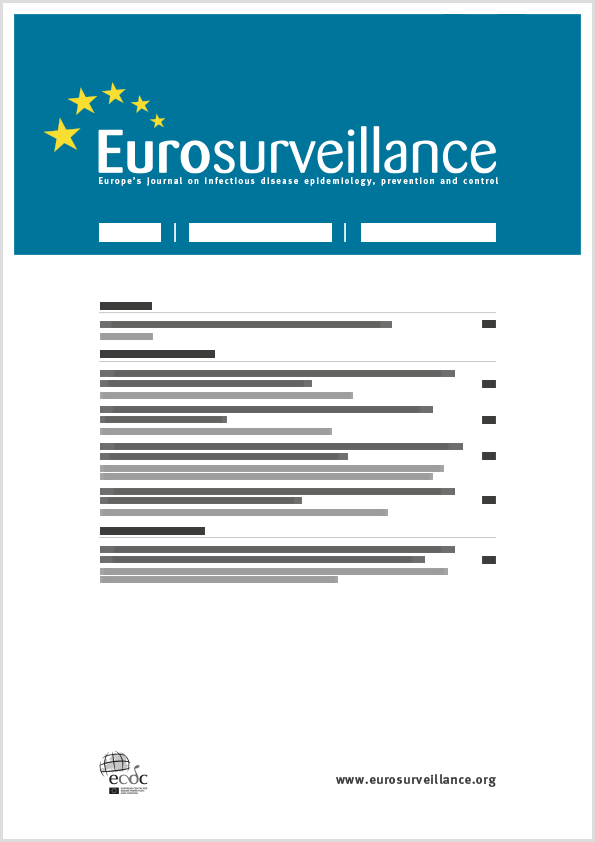- Home
- Eurosurveillance
- Previous Issues
- Volume 30, Issue 8, 27/Feb/2025
Eurosurveillance - Volume 30, Issue 8, 27 February 2025
Volume 30, Issue 8, 2025
- Surveillance
-
-
-
Assessment of the effectiveness of West Nile virus screening by analysing suspected positive donations among blood donors, Germany, 2020 to 2023
More LessBackgroundThe first autochthonous human West Nile virus (WNV)-positive cases in Germany were confirmed in 2019. Risk minimisation measures (RMM) were introduced in 2020; no WNV transfusion-transmitted infections have been reported to date.
AimTo analyse German suspected WNV-positive blood donations during annual seasons 2020–23 to review donor testing requirements.
MethodsWNV look-back procedures were initiated as per German regulations and additional donor data were collected. Blood samples were analysed by metagenomic next-generation sequencing (mNGS), individual donor nucleic acid amplification technique (ID-NAT)-based testing and antibody (Ab) testing.
ResultsSeventy-four cases were followed up after WNV-positive donor mini-pool screening. Forty-five (83%) of 54 samples tested with the cobas WNV assay and 14 (29%) of 49 samples tested with the RealStar WNV assay showed a reactive ID-NAT-based result; the viral load ranged between 70,251 IU/mL and values below quantification limits. Fifteen (23%) of 64 samples serologically tested were reactive with at least one of the three Ab tests performed; the previous WNV-negative donation was nearly always documented > 28 days before. Of 73 samples sequenced, mNGS detected WNV in 26 (36%) and other flaviviruses in 14 (19%) cases.
ConclusionIn some suspected cases where a WNV infection was not confirmed, mNGS demonstrated a cross-reaction with other flaviviruses. Ab testing could only detect WNV in late stages of infection. A NAT-based WNV donor screening with a detection limit of at least 120 IU/mL seems to be a sufficiently effective RMM at present. However, a continuous re-evaluation of test strategy is always required.
-
- Top
-
- Research
-
-
-
COVID-19 vaccine effectiveness in the paediatric population aged 5–17 years: a multicentre cohort study using electronic health registries in six European countries, 2021 to 2022
Patrícia Soares , Ausenda Machado , Nathalie Nicolay , Susana Monge , Chiara Sacco , Christian Holm Hansen , Hinta Meijerink , Iván Martínez-Baz , Susanne Schmitz , James Humphreys , Massimo Fabiani , Aitziber Echeverria , Ala’a AlKerwi , Anthony Nardone , Alberto Mateo-Urdiales , Jesús Castilla , Esther Kissling , Baltazar Nunes and VEBIS-Lot 4 working groupMore LessBackgroundDuring the first year of the COVID-19 pandemic, vaccination programmes targeted children and adolescents to prevent severe outcomes of SARS-CoV-2 infection.
AimTo estimate COVID-19 vaccine effectiveness (VE) against hospitalisation due to COVID-19 in the paediatric population, among those with and without previously documented SARS-CoV-2 infection.
MethodsWe established a fixed cohort followed for 12 months in Denmark, Norway, Italy, Luxembourg, Navarre (Spain) and Portugal using routine electronic health registries. The study commenced with paediatric COVID-19 vaccination campaign at each site between June 2021 and January 2022. The outcome was hospitalisation with a laboratory-confirmed SARS-CoV-2 infection or COVID-19 as the main diagnosis. Using Cox proportional hazard models, VE was estimated as 1 minus the confounder-adjusted hazard ratio of COVID-19 hospitalisation between vaccinated and unvaccinated. A random-effects meta-analysis was used to pool VE estimates.
ResultsWe included 4,144,667 5–11-year-olds and 3,861,841 12–17-year-olds. In 12–17-year-olds without previous infection, overall VE was 69% (95% CI: 40 to 84). VE declined with time since vaccination from 77% ≤ 3 months to 48% 180–365 days after immunisation. VE was 94% (95% CI: 90 to 96), 56% (95% CI: 3 to 80) and 41% (95% CI: −14 to 69) in the Delta, Omicron BA.1/BA.2 and BA.4/BA.5 periods, respectively. In 12–17-year-olds with previous infection, one dose VE was 80% (95% CI: 18 to 95). VE estimates were similar for 5–11-year-olds but with lower precision.
ConclusionVaccines recommended for 5–17-year-olds provided protection against COVID-19 hospitalisation, regardless of a previously documented infection of SARS-CoV-2, with high levels of protection in the first 3 months of the vaccination.
-
-
Volumes & issues
-
Volume 30 (2025)
-
Volume 29 (2024)
-
Volume 28 (2023)
-
Volume 27 (2022)
-
Volume 26 (2021)
-
Volume 25 (2020)
-
Volume 24 (2019)
-
Volume 23 (2018)
-
Volume 22 (2017)
-
Volume 21 (2016)
-
Volume 20 (2015)
-
Volume 19 (2014)
-
Volume 18 (2013)
-
Volume 17 (2012)
-
Volume 16 (2011)
-
Volume 15 (2010)
-
Volume 14 (2009)
-
Volume 13 (2008)
-
Volume 12 (2007)
-
Volume 11 (2006)
-
Volume 10 (2005)
-
Volume 9 (2004)
-
Volume 8 (2003)
-
Volume 7 (2002)
-
Volume 6 (2001)
-
Volume 5 (2000)
-
Volume 4 (1999)
-
Volume 3 (1998)
-
Volume 2 (1997)
-
Volume 1 (1996)
-
Volume 0 (1995)
Most Read This Month

-
-
Detection of 2019 novel coronavirus (2019-nCoV) by real-time RT-PCR
Victor M Corman , Olfert Landt , Marco Kaiser , Richard Molenkamp , Adam Meijer , Daniel KW Chu , Tobias Bleicker , Sebastian Brünink , Julia Schneider , Marie Luisa Schmidt , Daphne GJC Mulders , Bart L Haagmans , Bas van der Veer , Sharon van den Brink , Lisa Wijsman , Gabriel Goderski , Jean-Louis Romette , Joanna Ellis , Maria Zambon , Malik Peiris , Herman Goossens , Chantal Reusken , Marion PG Koopmans and Christian Drosten
-
- More Less


